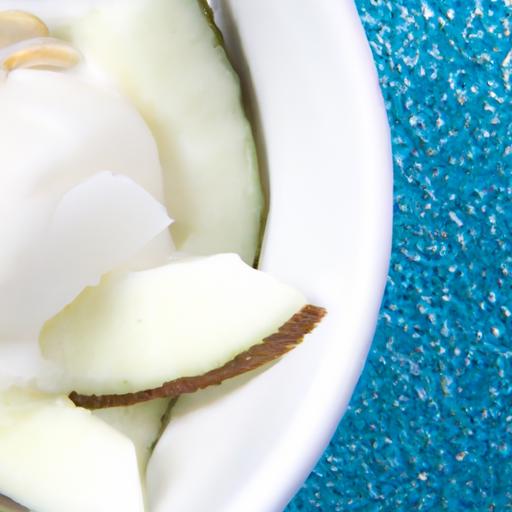Imagine a velvety spoonful of tropical paradise-rich, creamy, and subtly sweet-all captured in a jar of homemade coconut yogurt. Welcome to the world of Creamy Coconut Bliss: Crafting Your Own Homemade Coyo. As more people embrace dairy-free lifestyles and seek gut-friendly alternatives, coyo-short for coconut yogurt-has emerged as a luscious, probiotic-rich treat that’s as nourishing as it is delicious. In this article, we’ll dive into the art and science behind making your own coyo at home, unlocking the secrets to transforming simple coconut milk into a tangy, velvety delight that’s perfect for breakfasts, smoothies, and beyond. Get ready to embark on a culinary journey where health meets indulgence, all wrapped in the tropical warmth of coconut bliss.
Understanding the Magic of Coyo and Its Health Benefits
Creamy Coconut Bliss is more than a delightful treat-it’s a celebration of nature’s nurturing power. Coyo, a luscious coconut yogurt indigenous to tropical regions, offers a probiotic-rich alternative bursting with natural goodness and a vibrantly creamy texture. The magic lies in its fermentation, which transforms fresh coconut milk into a tangy, velvety masterpiece that supports digestion, strengthens the immune system, and provides healthy fats essential for brain health. Whether you’re embracing dairy-free living or simply seeking a refreshing, wholesome snack, crafting Coyo grants nourishment with every spoonful.
Selecting the Perfect Coconut and Ingredients for Authentic Flavor
Embarking on creating this Creamy Coconut Bliss begins with choosing the freshest, highest-quality coconut. Opt for young, green coconuts if you prefer a sweeter, lighter yogurt, or mature brown coconuts for a richer, deeper flavor. The secret to authentic taste is natural, unprocessed coconut milk, free from additives. To enhance fermentation, select a reliable probiotic starter or live kefir grains designed for plant-based milks. A touch of natural sweetener like organic honey or maple syrup encourages microbial activity while maintaining purity.
Prep and Cook Time
- Preparation: 15 minutes
- Fermentation Time: 24-36 hours (depending on ambient temperature)
Yield
Approximately 2 cups (serves 4)
Difficulty Level
Easy to Medium – Perfect for homemade fermentation enthusiasts
Ingredients
- 2 cups fresh coconut milk (homemade or canned, full fat)
- 1 teaspoon probiotic powder or 1 tablespoon live kefir grains
- 1 teaspoon organic maple syrup or honey (optional, for fermentation boost)
- 1/4 teaspoon vanilla extract (optional, for subtle sweetness)
Step-by-Step Guide to Achieving Creamy Texture and Ideal Fermentation
- Prepare the coconut milk: For the creamiest texture, shake canned coconut milk or whisk fresh homemade milk until smooth and silky.
- Combine ingredients: In a sanitized glass jar, mix the coconut milk, probiotic starter, and maple syrup gently-avoid vigorous shaking to preserve cultures.
- Cover and incubate: Loosely cover the jar with a breathable cloth or lid and leave it at room temperature (70-75°F) for 24-36 hours. Warmer environments speed fermentation, but longer times deepen tanginess.
- Check consistency: Once thickened to a creamy yogurt-like texture, stir gently to homogenize.
- Flavor infusion (optional): Stir in vanilla extract or your preferred natural flavorings carefully.
- Refrigerate: Chill your Coyo for at least 6 hours to set the texture fully and enrich flavors.
Tips and Tricks for Storing, Serving, and Flavoring Your Homemade Coyo
Store your Creamy Coconut Bliss in an airtight container in the refrigerator for up to 7 days. For longer shelf life, freeze in small portions, perfect for smoothies or frozen desserts. Experiment with garnishes such as fresh tropical fruits, toasted coconut flakes, or a drizzle of raw honey for extra indulgence. To customize, blend in superfoods like chia seeds or spirulina post-fermentation for a nourishing boost. Remember, gentle stirring preserves the airy texture, while aggressive mixing can thin your yogurt.
Chef’s Notes
- Probiotic variety: Different starters yield unique flavor profiles; try multiple probiotics to find your favorite tang and texture.
- Milk substitutes: This method works beautifully with almond or cashew milk but expect thinner results.
- Fermentation environment: Maintaining a consistent warm temperature enhances reliability-use a yogurt maker or warm spot in the kitchen.
- Sweetener tips: Non-refined sweeteners help cultures thrive without overpowering natural coconut tastes.
- Troubleshooting: If your Coyo turns watery or fails to thicken, extend fermentation time or increase probiotic quantity slightly.
Serving Suggestions
Elevate your homemade Coyo by serving it with vibrant tropical fruit bowls-think ripe mango, juicy pineapple, or fresh berries. Pair it with crunchy granola for a contrast in textures, or swirl in pureed passionfruit or cacao nibs for gourmet layers of flavor. A sprinkle of toasted coconut or a dash of cinnamon brings warm aromas that complement the creamy consistency.
| Nutrient | Amount per Serving (1/2 cup) |
|---|---|
| Calories | 180 |
| Protein | 2g |
| Carbohydrates | 6g |
| Fat | 16g |
Discover more about plant-based yogurts and fermentation tips in our comprehensive Plant-Based Yogurt Guide. For probiotics’ science and health benefits, visit NCBI Probiotic Research.

Q&A
Q&A: Creamy Coconut Bliss – Crafting Your Own Homemade Coyo
Q1: What exactly is Coyo, and why is it gaining popularity?
A1: Coyo is a luscious, creamy coconut yogurt that captures the tropical essence of coconuts in every spoonful. Unlike traditional dairy yogurts, Coyo is plant-based, probiotic-rich, and naturally dairy-free-making it a beloved treat for vegans, lactose-intolerant individuals, and health enthusiasts alike. Its rising popularity stems from its delightful creaminess paired with gut-friendly benefits.
Q2: What makes homemade Coyo different from store-bought versions?
A2: Homemade Coyo lets you take control of every ingredient and customize it to your taste. You avoid preservatives, additives, and unnecessary sweeteners often found in commercial brands. Plus, crafting it yourself is a creative, rewarding process that connects you to the magic of fermentation and tropical flavors.
Q3: What are the essential ingredients needed to make your own Coyo?
A3: The core elements include fresh or canned full-fat coconut milk (the creamiest base), a probiotic starter culture (either a store-bought probiotic capsule or a spoonful of plain yogurt with live cultures), and a touch of sweetener like maple syrup or agave if desired. Optional ingredients can include vanilla extract or a pinch of salt to enhance flavor.
Q4: Can you describe the basic steps in crafting homemade Coyo?
A4: Certainly! Start by warming the coconut milk gently to create the perfect cozy environment for the probiotics. Stir in your chosen starter culture thoroughly, cover the mixture, and let it ferment in a warm place (around 75-80°F) for 24 to 48 hours. The wait varies depending on your taste preference for tanginess and thickness. Then, chill it to set the creamy texture, and voilà-a bowl of tropical bliss awaits!
Q5: How do you ensure a thick, creamy consistency similar to store-bought coconut yogurt?
A5: Achieving that luxurious tangy thickness hinges on the quality of coconut milk (full-fat works best) and the duration of fermentation. You can strain the yogurt through cheesecloth or add a natural thickener like tapioca starch or agar agar before fermenting. Also, be patient-the longer fermentation enhances both flavor and creaminess.
Q6: Are there any tips for maximizing the probiotic benefits in homemade Coyo?
A6: Absolutely. Use fresh, high-quality probiotic capsules or live cultures to kickstart fermentation. Maintain a warm, stable temperature during incubation, and avoid heating the yogurt after fermentation, as heat kills the probiotics. Enjoy your Coyo cold and fresh for the best gut-friendly boost!
Q7: How can one enjoy homemade Coyo beyond just eating it plain?
A7: The possibilities are as vast as the tropics themselves! Swirl in fresh fruit, granola, toasted coconut flakes, or a drizzle of honey or agave nectar. Use it as a creamy base for smoothie bowls, tropical parfaits, or even as a dairy-free substitute in baking recipes. It’s your creamy canvas for delicious creativity.
Q8: Any sustainability benefits to making Coyo at home?
A8: Indeed. Homemade Coyo reduces reliance on packaged yogurts with plastic containers, cuts down food miles, and minimizes food waste by using leftover coconut milk. It’s a small step with a big impact toward mindful, eco-friendly living.
Q9: How long can homemade Coyo be stored, and how should it be stored?
A9: Store your Coyo in an airtight container in the refrigerator. It typically stays fresh and flavorful for about 5 to 7 days. Always use clean utensils to avoid contamination, and give it a gentle stir before serving.
Q10: Where can beginners find reliable probiotic starters to begin their Coyo journey?
A10: Probiotic capsules from health food stores or online retailers are an easy and accessible source. You can also experiment with a spoonful of plain, live-culture coconut yogurt as a starter. Just make sure the starter culture contains live, active bacteria strains to kick off fermentation effectively.
Embark on your creamy coconut bliss journey today-homemade Coyo is a tropical treasure waiting in your kitchen!
Key Takeaways
As you embark on your own journey to create this luscious, dairy-free delight, remember that crafting homemade Coyo is more than just a recipe-it’s an invitation to celebrate the creamy richness of coconut in its purest form. With each spoonful of your silky, tangy creation, you’re not just enjoying a treat; you’re embracing a little moment of tropical bliss right in your own kitchen. So gather your ingredients, trust the process, and savor the sweet satisfaction of making your very own Creamy Coconut Bliss-because sometimes, the best things in life truly are homemade.


